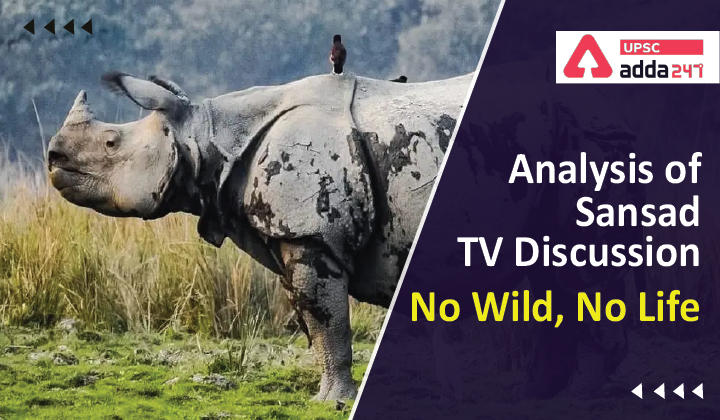Table of Contents
Analysis of Sansad TV Discussion: ‘No Wild, No Life’
Relevance
”GS 3: Environmental Pollution & Degradation, Conservation”
Introduction
In keeping with the tradition of celebrating a particular theme every year, the theme for World Wildlife Day 2022 is ‘Recovering Key Species for Ecosystem Restoration’.
About World Wildlife Day
- On 20 December 2013, the United Nations General Assembly proclaimed March 3, the international day of adoption of the Convention on International Trade in Endangered Species of Wild Fauna and Flora (CITES) as World Wildlife Day.
- The day aims to celebrate and raise awareness about the world’s wild flora and fauna.
Why there is a need to recover?
- Since 1970, populations of mammals, birds, fishes, amphibians and reptiles have dropped unimaginably by an average of 70%.
- At the same time, natural environments are constantly degraded and annihilated.
- These two trends have a causal relationship in the sense that degradation and loss of habitat can lead to population decline and, eventually, extinctions.
What do Data say?
- According to data from the International Union for Conservation of Nature (IUCN) Red List of Threatened Species, over 8,400 species of wild fauna and flora are critically endangered, while close to 30,000 more are understood to be endangered or vulnerable.
- As per this data 239 faunal species which are known to occur in India are classified as endangered species which includes 45 species of mammals, 23 species of birds, 18 species of reptiles, 39 species of amphibians and 114 species of fishes.
- India has a network of 733 Protected Areas including 103 National Parks, 537 Wildlife Sanctuaries, 67 Conservation Reserves and 26 Community Reserves covering approximately 4.89 per cent of the country’s geographical area.
Human and Nature
- Humans rely on wildlife and biodiversity-based resources to meet all our needs from food to fuel, medicines, housing, and clothing.
- Millions of people are also dependent on nature as the source of their livelihoods and economic opportunities.
Why do we choose regions for protection?
- Few regions should receive more focus than others, solely due to the human pressures they face, such as the Leatherback sea turtles (IUCN status Vulnerable) in Great Nicobar island’s Galathea Bay, gharials (IUCN status Critically Endangered) in the Ken Gharial Sanctuary of Madhya Pradesh and Royal Bengal tigers (IUCN status Endangered) in West Bengal’s Sundarban mangroves, to name a few.
Conclusion
There is no doubt about the fact that a thriving ecosystem will support flourishing biodiversity, and with it, the key species of that particular habitat will also prosper. Therefore, it is imperative to note that the protection and conservation of habitats is the most crucial step to recovering key species for the purpose of ecosystem restoration.



 TSPSC Group 1 Question Paper 2024, Downl...
TSPSC Group 1 Question Paper 2024, Downl...
 TSPSC Group 1 Answer key 2024 Out, Downl...
TSPSC Group 1 Answer key 2024 Out, Downl...
 UPSC Prelims 2024 Question Paper, Downlo...
UPSC Prelims 2024 Question Paper, Downlo...
